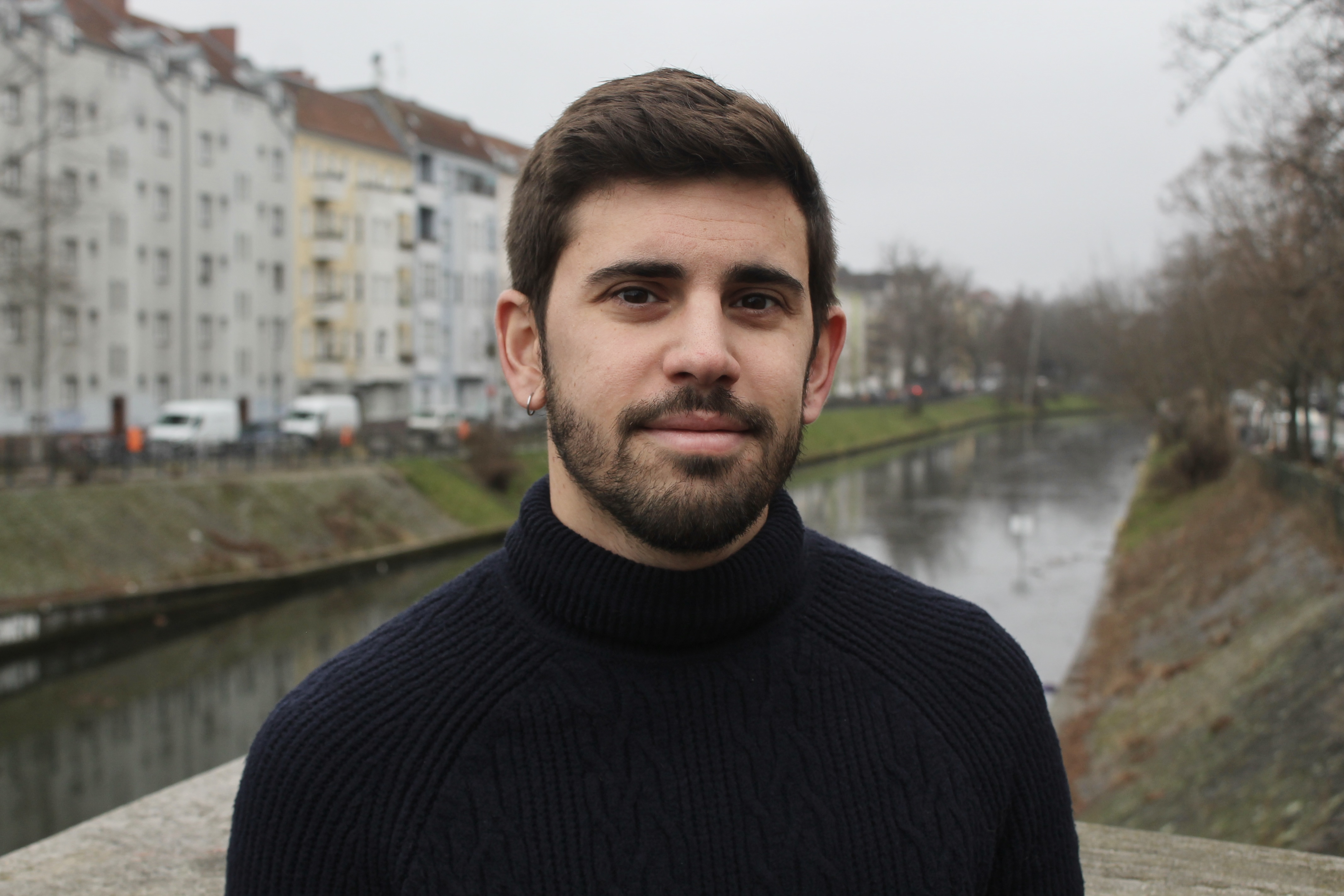How the first impartial LGBTQ+ news brand gathered almost 140,000 followers on TikTok

Enrique Anarte.
This interview was first published by Italian journalist Francesco Zaffarano in his biweekly Substack newsletter, Mapping journalism on social platforms. The original is available at this link. Sign up for the newsletter here.
Openly, the Thomson Reuters Foundation’s LGBTQ+ news brand, is the world’s first impartial queer news outlet on TikTok, where it has close to 140,000 followers, posting a variety of videos ranging from tips for LGBTQ+-friendly travel to news developments relevant to the community and queer history.
Francesco spoke with Enrique Anarte, who leads Openly’s TikTok team. Anarte worked for several years as a multimedia journalist for Deutsche Welle (DW), Germany’s international broadcaster. During his time there, he helped develop several social formats for the Latin American service and co-led DW’s first award-winning TikTok channel – DW Berlin Fresh.
Q. What makes Openly different from other accounts covering LGBTQ+ stories?
A. I think what makes Openly unique is that we produce impartial, trustworthy journalism about LGBTQ+ issues for a TikTok audience. Let me break down these three main points:
- Unlike other queer news outlets on TikTok or outside the platform, we are impartial, just like any other journalism produced by Thomson Reuters. That doesn’t mean we cannot – and that’s the biggest challenge – play with the platform's language, but impartiality is part of our essence, and we don’t want to be anything else.
- I put a strong focus on trust because our content is subject to the same fact-checking process as any other journalistic format produced at the Thomson Reuters Foundation. We might speak a different language, but we’re as accurate and trustworthy as our colleagues are. And I think that’s very important in the age of widespread misinformation we live in, particularly, but not only, on social media.
- The third element I’d like to stress is that we produce journalism for this platform. We don’t just cut traditional social videos we would have made for Facebook, Twitter, or Instagram in a vertical format and post them on TikTok. Yes, these videos also perform very well because there is huge user engagement now on TikTok. But I believe there is something unique to TikTok, a different language and the possibility to break with traditional schemes, to take things to a new level - more tangible, more user-friendly, more personal in the sense that we stop talking down to our audience and start a conversation with them. That’s what we do at Openly, and it’s an element that I’m very proud of, especially because I think it reinforces the element of trustworthiness that I mentioned before by creating a more personal relationship with the audience.
@openlynews ♬ som original - moon ?
Q. How does your TikTok presence fit into your wider company strategy?
A. The Thomson Reuters Foundation launched Openly to provide impartial LGBTQ+ journalism to global audiences. Our TikTok channel targets audiences who may not frequently use traditional websites or more mature social platforms but are interested in watching and engaging with queer stories worldwide. We aim to stay true to our brand and build brand awareness and trust among younger audiences who may not be familiar with us.
This aligns with the Thomson Reuters Foundation’s broader goal of building global awareness of some of humanity's most critical issues, inspiring collective leadership, and helping to shape a prosperous world where no one is left behind. TRF focuses on fostering more inclusive economies, advancing media freedom, and promoting human rights.
Q. How many people work on your TikTok account?
A. I was part of the team that launched the account in July 2021 with my co-host Shivani Dave and under the supervision of our managers at the Thomson Reuters Foundation. Until recently, the team consisted of Shivani and me working part-time and taking care of writing, producing, and managing the account. However, we also fully plugged into the wider Openly news team and leveraged knowledge, insight, and expertise across the Foundation.
Starting this month, I’ve just started working full-time on the account. One of our goals will be to set up a worldwide network of freelance reporters that allows us to become a truly global LGBTQ+ news brand on the platform and reach new audiences beyond Europe and the US, with Africa and Asia being key areas for audience development.
Q. Do you have recurrent formats/shows?
A. We have vox pops in the streets of cities like London, Berlin, and San Francisco; the latest viral trends with an informational or an educational twist; at-home explainers about all sorts of current topics, from the last Italian election to using non-binary language in Bulgarian; presenter-led travel videos with queer tips for those visiting Warsaw, Milan or Manchester; short interviews where we feature voices that matter to the LGBTQ+ community and their allies, from a gay Belarusian refugee in Germany to a trans activist fighting against forced sterilisation in Prague; comedy and fun content, from gay astrology to who’d be the education and defence ministers in an LGBTQ-only country; and outdoor explainers in which we present current topics and issues from the cities we’re based in.
Q. What is the TikTok-specific project you are most proud of?
A. Our ongoing series on non-binary pronouns and language in different languages, which no other media account or individual creator (that I’m aware of!) had done before us. This series helped us reach young audiences beyond the English-speaking world. And I think it stands for what we, Openly, are as a news brand.
@openlynews The Cambridge Dictionary has expanded its definition of the words “woman” and “man” to be inclusive of transgender women and men. Do you know any dictionaries where you live that are making efforts to include trans and non-binary people? #lgbtnews #transawarenes #transrights ♬ Dancing In The Moonlight x Pumped Up Kicks - darcy stokes
Q. What project or experiment would you love to do on TikTok?
A. I would love to develop an impartial, journalistic project tackling misinformation about trans issues (in the line of @transathletica.series) at an international level that doesn’t stick to traditional news formats.
Q. What metrics do you use to analyse your content performance and why?
A. The first thing to consider is who’s our target audience. In our case - to keep it simple - it’s young LGBTQ+ people and allies worldwide, not only in the US and the UK. Therefore, even if a video hits a million views or generates tons of engagement, is it reaching all the people Openly TikTok was born for?
We use the more “mainstream” metrics (views, comments, shares, watch time, favourites, etc.). Still, we also pay attention to the quality of the engagement, the variety of the content, the value of the information as public service journalism, etc. I will say that, in terms of quantitative metrics and as a TikTok user, I’m a big fan of shares and favourites.
To assess the qualitative dimensions of the engagement, we think: was it mostly positive? Did the video inspire/educate people? Or did most of the audience use the comment section to attack sexual minorities or other groups? Was there a respectful debate, which is vital for an impartial outlet covering LGBTQ+ news?
Q. Do you interact with your audience on TikTok? How?
A. All the time! We do intensive community management – listening and responding appropriately to their feedback and concerns –provide additional information on the topic based on our users’ questions, and even produce new videos based on their feedback and questions.
@openlynews Replying to @Princesabaudo Italy’s financial and fashion capital isn’t everyone’s cup of tea - but it has a vibrant LGBTQ+ scene (and lots of direct flights from many European cities!). #milan #milano #portavenezia ♬ оригінальний звук - Слухай найкраще ?
Q. What is one thing you have learned while working on TikTok?
A. Social media hasn’t made journalism worse, as many claim: it made us more humble and accountable and shown us that for decades we’ve been living in a castle in the sky where we unilaterally decided what mattered to people and how much.
Q. One thing you would like to change on TikTok?
A. Please remove the Friends page and bring the Discover page back - this isn’t Facebook! And bring back pinned comments: they’re a great way to complement or clarify the information you’ve given in the video - otherwise, it gets lost among the users' comments.
Q. What would you do differently if you started your account today?
A. I would dedicate less time to doing what works for other accounts - with other brands, more resources, or just different goals - and focus on what makes Openly unique, what people love about us.
Q. Which three accounts should we check out on TikTok?
A. @ineshernand is doing a great job educating and informing people in Spain in a fun and entertaining way. I learn so much from German historian and journalist @heeyleonie. And Madrid’s Prado museum @museodelprado is the BEST museum account on the platform.
Editor's note: Thomson Reuters Foundation is the charitable arm of multinational media conglomerate Thomson Reuters and a core funder of the Reuters Institute for the Study of Journalism. More information about the Institute's funding can be found in this link.
Italian journalist Francesco Zaffarano has recently launched a biweekly Substack newsletter, Mapping journalism on social platforms, featuring interviews with people leading news innovation on social media. Here's the latest interview he published, lightly edited for brevity and clarity. The original is available at this link. Sign up for the newsletter here.






